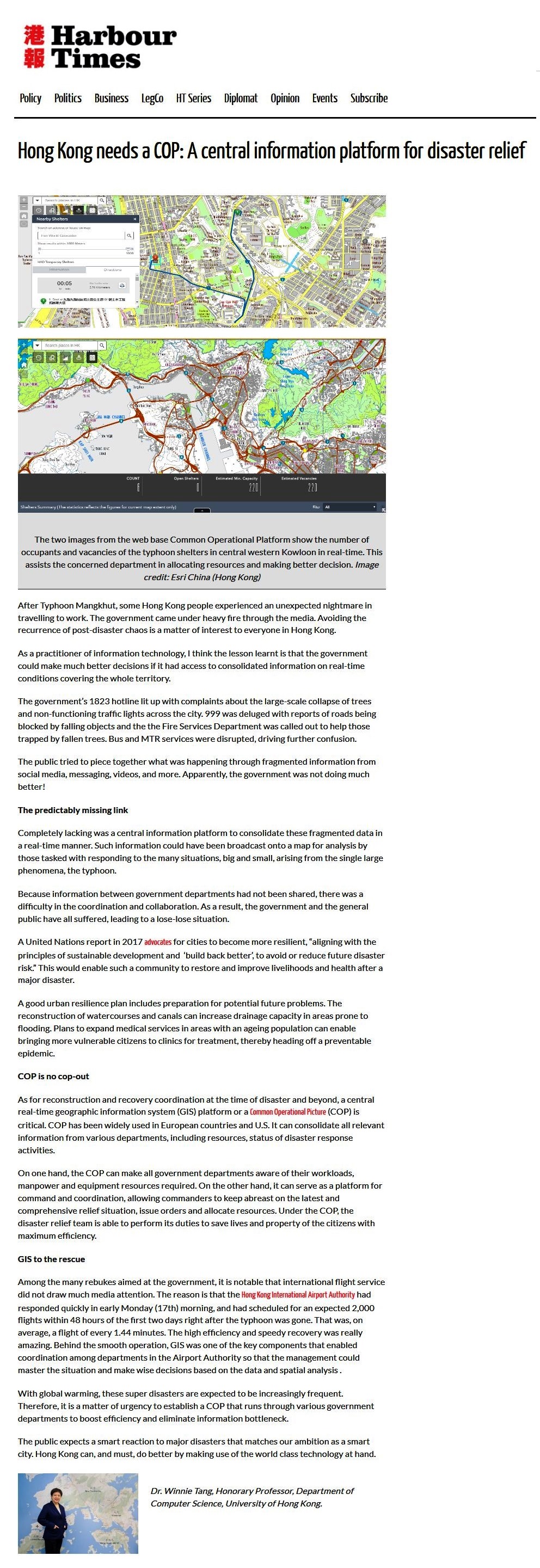網上版請按此

Hong Kong needs a COP: A central information platform for disaster relief
After Typhoon Mangkhut, some Hong Kong people experienced an unexpected nightmare in travelling to work. The government came under heavy fire through the media. Avoiding the recurrence of post-disaster chaos is a matter of interest to everyone in Hong Kong.
As a practitioner of information technology, I think the lesson learnt is that the government could make much better decisions if it had access to consolidated information on real-time conditions covering the whole territory.
The government's 1823 hotline lit up with complaints about the large-scale collapse of trees and non-functioning traffic lights across the city. 999 was deluged with reports of roads being blocked by falling objects and the the Fire Services Department was called out to help those trapped by fallen trees. Bus and MTR services were disrupted, driving further confusion.
The public tried to piece together what was happening through fragmented information from social media, messaging, videos, and more. Apparently, the government was not doing much better!
The predictably missing link
Completely lacking was a central information platform to consolidate these fragmented data in a real-time manner. Such information could have been broadcast onto a map for analysis by those tasked with responding to the many situations, big and small, arising from the single large phenomena, the typhoon.
Because information between government departments had not been shared, there was a difficulty in the coordination and collaboration. As a result, the government and the general public have all suffered, leading to a lose-lose situation.
A United Nations report in 2017 advocates for cities to become more resilient, "aligning with the principles of sustainable development and 'build back better', to avoid or reduce future disaster risk." This would enable such a community to restore and improve livelihoods and health after a major disaster.
A good urban resilience plan includes preparation for potential future problems. The reconstruction of watercourses and canals can increase drainage capacity in areas prone to flooding. Plans to expand medical services in areas with an ageing population can enable bringing more vulnerable citizens to clinics for treatment, thereby heading off a preventable epidemic.
COP is no cop-out
As for reconstruction and recovery coordination at the time of disaster and beyond, a central real-time geographic information system (GIS) platform or a Common Operational Picture (COP) is critical. COP has been widely used in European countries and U.S. It can consolidate all relevant information from various departments, including resources, status of disaster response activities.
On one hand, the COP can make all government departments aware of their workloads, manpower and equipment resources required. On the other hand, it can serve as a platform for command and coordination, allowing commanders to keep abreast on the latest and comprehensive relief situation, issue orders and allocate resources. Under the COP, the disaster relief team is able to perform its duties to save lives and property of the citizens with maximum efficiency.
GIS to the rescue
Among the many rebukes aimed at the government, it is notable that international flight service did not draw much media attention. The reason is that the Hong Kong International Airport Authority had responded quickly in early Monday (17th) morning, and had scheduled for an expected 2,000 flights within 48 hours of the first two days right after the typhoon was gone. That was, on average, a flight of every 1.44 minutes. The high efficiency and speedy recovery was really amazing. Behind the smooth operation, GIS was one of the key components that enabled coordination among departments in the Airport Authority so that the management could master the situation and make wise decisions based on the data and spatial analysis .
With global warming, these super disasters are expected to be increasingly frequent. Therefore, it is a matter of urgency to establish a COP that runs through various government departments to boost efficiency and eliminate information bottleneck.
The public expects a smart reaction to major disasters that matches our ambition as a smart city. Hong Kong can, and must, do better by making use of the world class technology at hand.
Dr. Winnie Tang
Honorary Professor, Department of Computer Science, The University of Hong Kong